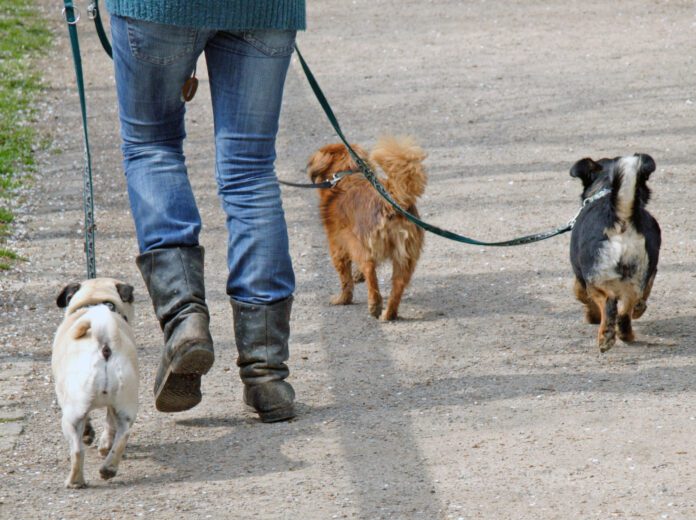Of course, you can walk two dogs at once, or, as I do, sometimes three. If you can’t walk two of your own dogs at the same time, it’s a training problem and, usually, the problem is distractions—things the dog(s) want, causing them to get excited and out of control. That can be trouble with two dogs on leash together. You can only walk two dogs at once if they know each other and are both calm and trained to walk on leash.
Twenty years ago, I learned that the hard way—trying to manage my three Shelties in a frenzy due to a passing car! I learned what happens when your dog isn’t taught to ignore distractions when asked to do so. And now, I always include this lesson in my basic classes. Just imagine walking two dogs at once when one sees a squirrel . . . Let’s begin.
Basics
First, you don’t need any special equipment. Here’s all you need:
- A well-fitted collar or harness
- A leash no longer than six feet (absolutely no retractable leashes)
- Treats (lots of good ones)
Pulling is sometimes part of the issue when walking two dogs, or with one dog for that matter. If you have a puller, work on that before walking two dogs at once.
Start With One Dog
In this short piece, we are going to focus on distraction training and assume your dog knows how to walk quietly on a leash and other basic cues like sit, wait, and a release cue. If not, you need to read “Polite Leash Walking.”
For help with teaching your dog to disengage from things he finds distracting, see “Teach Your Dog to ‘Leave It’ Without a Cue.” Teaching your dogs, individually, to handle distractions and return their attention to you is worth every minute you can put into it. Do all these same training steps with your other dog, too. Take your time.
Putting Them Together
When your dogs have met your walking criteria individually, such as sitting on cue or returning their attention to you even when something tantalizing is nearby, take them for a walk together in a quiet area. Practice away from traffic, then gradually introduce triggers and distractions. They should both sit on cue and be rewarded. Make the intensity of the triggers gradually more difficult.
Not successful? Go back to square one. (Someone once said, “Don’t complain, train!” But no one ever said it was easy.)
I can often be seen in the neighborhood pushing a stroller with my elderly Sheltie inside, and a couple of Goldens or Shelties trotting alongside. Folks are amazed that I can do this with my dogs. I tell them, “No magic here … just training.”






I walk my 3 all the time. I got all of them as adult rescues. Journey and Pearl were excellent walkers before I got them and walked well together from the beginning, and it’s been no problem to add a 3rd dog. Even Ben, who is my newest rescue family member, walks nicely, and that’s after coming to me scared to death of the leash. He saw his dog sisters going every morning and decided maybe it wasn’t so scary, and now is the perfect third member. I credit Pearl and Journey as much as any training I did for showing him how it’s done. We get comments often from people we meet on our walks about how well-behaved they are. I’m lucky – they’ve never been pullers, and are just happy to go. One man said that most people are getting taken for a walk by their dogs, while my dogs and I go for a walk together, and that’s about right.
Loved your article. I help my clients with basic leash walk walking and training, and I have found that our Beagle mix was a great help in showing other dogs how to do it right. However, I had spent a lot of time training him to ignore squirriels and cats, but it is always a pleasure to pass on knowledge to other dog owners who also want a well behaved hound.
Dog behaviour is quite complicated so a dog might be reacting emotionally to their situation and this has to be considered. You cannot train a fear response using operant conditioning and adding a tool such as a Halti could make things worse unnecessarily,
I have two rescues who walk very well on a loose leash provided I keep them under threshold for fear triggers. If I make them walk together, they add to each others stress and I would prefer that they have a pleasant walk.
After all, the walk is for the dogs to sniff and explore their world and not for me.
It helps that I have a certificate in dog behaviour and know when they are stressed.